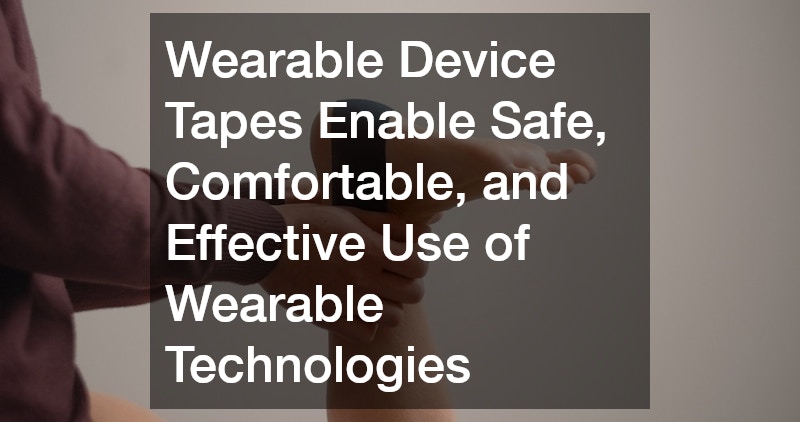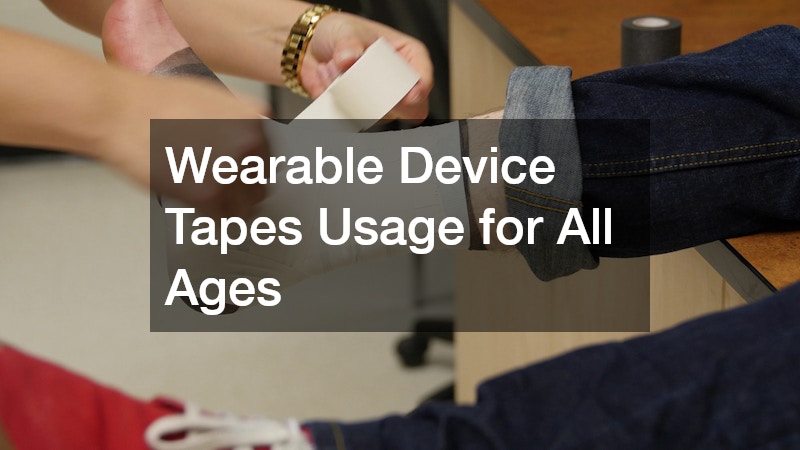As technology continues to integrate seamlessly into our daily lives, wearable devices have become increasingly common. From fitness trackers and smartwatches to medical monitors and glucose sensors, these innovations help us stay connected, monitor our health, and improve our overall quality of life. A critical but often overlooked component in the comfort and effectiveness of these devices is the use of wearable device tapes—specialized adhesives designed to secure devices to the skin safely and reliably.
These tapes play an essential role in ensuring that wearable technology performs effectively across a wide range of age groups, from infants to seniors. In this post, we’ll explore how wearable device tapes are being used across different age demographics, the challenges they address, and why they are a vital part of the future of healthcare and lifestyle technology.
Understanding Wearable Device Tapes
Wearable device tapes are specially engineered medical-grade adhesives that secure electronic health and lifestyle devices to the skin. These tapes must be skin-friendly, breathable, water-resistant, and long-lasting, while also being gentle enough for sensitive skin. Unlike traditional adhesives, wearable device tapes are designed to stay in place during movement, sweat, and even sleep, without causing irritation or discomfort.
Given the vast range of uses, wearable device tapes must cater to diverse skin types, activity levels, and health conditions—making versatility and adaptability key features.
Wearable Device Tapes for Infants and Children
Children and infants, especially those in neonatal care, often require medical monitoring that involves attaching sensors directly to the skin. However, their skin is significantly more delicate than that of adults, making the choice of adhesive critical. In neonatal intensive care units (NICUs), wearable device tapes are used to secure vital signs monitors, temperature probes, and oxygen saturation sensors.
These tapes must meet strict safety standards to prevent skin damage. Pediatric-specific tapes often include hypoallergenic materials and use gentle adhesives that are still capable of holding devices in place securely. Their soft, breathable structure minimizes the risk of irritation or pressure sores, even with prolonged use.
In non-medical settings, children using activity monitors or smartwatches benefit from wearable device tapes that enhance comfort and prevent devices from slipping off during play or physical activity. These tapes offer parents peace of mind by keeping devices securely in place without harming their child’s skin.
Teenagers and Young Adults: Combining Style with Functionality
The teenage and young adult demographic is one of the most active users of wearable tech. Whether it’s a fitness tracker to log steps, a smartwatch to stay connected, or a patch-based acne treatment system, these devices are part of daily routines.
For this group, wearable device tapes need to strike a balance between functionality and aesthetic appeal. Tapes in this category often come in various colors or designs, allowing for personalization while ensuring strong adhesion during sports, exercise, and day-to-day movement.
Furthermore, teenagers who use wearable medical devices like insulin pumps or CGMs rely heavily on dependable tapes that can handle their busy, active lifestyles. The ability of the adhesive to withstand sweat and water exposure is especially important, as it ensures that medical data collection remains uninterrupted.
Adults: A Growing Demand for Stability and Comfort
Adults, especially those managing chronic conditions or engaged in intense physical activities, benefit significantly from reliable wearable device tapes. Whether it’s during a workout, a long workday, or travel, the tape’s ability to stay adhered comfortably to the skin is crucial.
Medical-grade wearable tapes are widely used for adult patients managing diabetes, cardiac conditions, or recovering from surgeries. These tapes ensure that diagnostic devices stay in place for extended periods without constant reapplication, which improves data accuracy and reduces inconvenience.
Even in the workplace, wearable technology is becoming more prevalent. Devices that monitor posture, fatigue, or environmental exposure rely on tapes that are discreet and durable, blending seamlessly into professional attire while delivering continuous performance.
Seniors: Enhancing Safety and Ease of Use
As the aging population grows, wearable technologies are playing an increasing role in elder care. From fall detection and heart rate monitoring to sleep analysis and medication reminders, seniors benefit from wearables that allow for remote monitoring and independence.
However, aging skin presents its own set of challenges—thinner, more fragile, and prone to tearing. Therefore, wearable device tapes for seniors must prioritize skin protection while maintaining reliable adhesion. Many products in this category feature low-tack adhesives with gentle removal properties, along with breathable materials that prevent skin maceration.
Wearable device tapes used by seniors often accompany devices that are essential for emergency response or daily health monitoring. A reliable adhesive reduces the risk of device detachment, which can be life-threatening in critical health situations.
From newborns in intensive care to seniors living independently, wearable device tapes play a crucial role in enabling the safe, comfortable, and effective use of wearable technologies. As the demand for health and lifestyle wearables grows across all age groups, so does the importance of high-quality, skin-friendly adhesives. Whether used for a medical monitor, fitness tracker, or smart health patch, the right wearable tape ensures that these devices can truly integrate into daily life—without irritation, inconvenience, or compromise.
.


